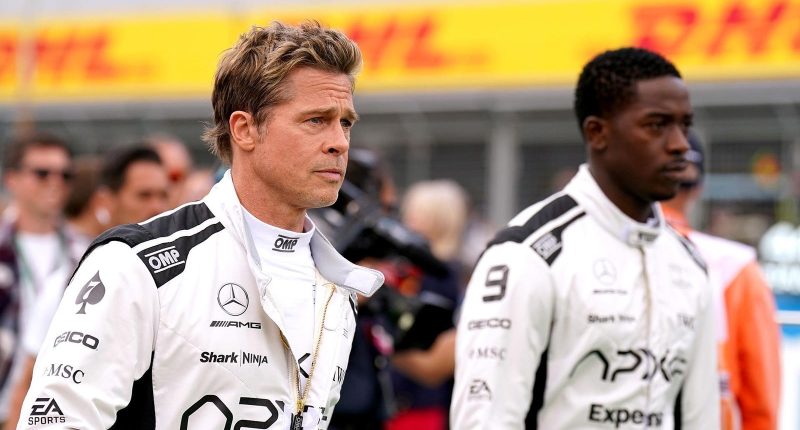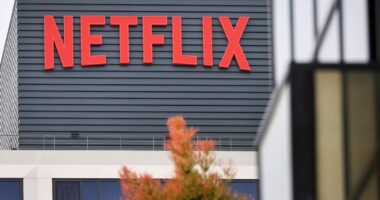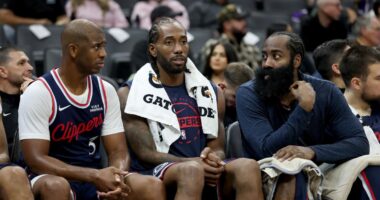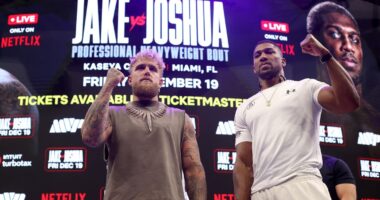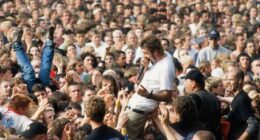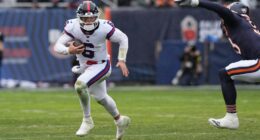Share this @internewscast.com
Mercedes, IWC, Expensify and other brands paid millions to sponsor a fictional Formula 1 team in Apple’s new F1 movie, which blurs the line between cinema and commerce—and could shape the future of both.
For the past three years, Apple has been selling F1 as a can’t-miss summer blockbuster set in the high-octane world of Formula 1, with the prestige of producer Jerry Bruckheimer, director Joseph Kosinski and star Brad Pitt. But for David Leener, the producer in charge of the movie’s product placement, his sales pitch was far simpler—turning one of the world’s highest-paid actors (Pitt is earning an estimated $30 million for this film) into a human billboard.
For significant portions of the film, Pitt’s character wears fire suits, helmets and other apparel adorned with more than a dozen logos for brands, including Mercedes, IWC, Geico, EA Sports and Expensify, each of which also have branding on the fictional APXGP team’s car and paid millions for the privilege.
Leener, a pioneer of brand integrations in movies for nearly 30 years, says he brought in more sponsor money for F1 than any film in his career—including Top Gun: Maverick, the two National Treasure pictures and several Transformer movies—by far. Forbes estimates Leener’s sponsorships for F1 have brought in at least $40 million, covering a significant part of a production budget that may be as high as $300 million. And that doesn’t include the tens of millions spent in cross-promotional ads, where brands (some of whom don’t actually appear onscreen) feature the movie in commercials for their own products.
“When [Mercedes-AMG Petronas F1 team CEO] Toto Wolff found out how much I had raised for our little team, he offered me a job on the spot,” Leener says with a laugh. “Jerry [Bruckheimer] was sitting right there, and I was like, ‘No, I’m good.’ I have a feeling Toto is a little intense to work for.”
Leener may be very good at his job, but sponsorship in Formula 1 and product placement in the F1 movie are fundamentally different propositions. To get your company’s logo on the front wing of an actual F1 car would cost at least $5 million per year, according to The Race Media founder and CEO Andrew Van de Burgt, while title sponsorships range from $30 million at the low end to $100 million per year for the most popular teams.
That sort of sponsorship comes with television exposure and prestige by association, but Van de Burgt acknowledges that there are dozens of brands that pay tens of millions of dollars to be involved in Formula 1 despite most fans having absolutely no idea what the company is or does.
“What those people are really paying for is to be in the paddock and have access to other big companies they want to work with,” he says. “If you can do 20 multimillion-dollar deals because you’re sitting next to the CEO or whoever you need to speak to, that more than justifies the spend.”
Logo-a-Gogo: Producer David Leener says that the estimated $40 million in sponsorship money he brought in for ‘F1’ is the most in his career—perhaps the most of all-time.
David Leener
Movie product placement, on the other hand, is traditionally sold in segments of three to four cumulative on-screen seconds of “clear and identifiable exposure,” says Leener. Its value depends on the amount of logos, verbal mentions or usages in those seconds, and can cost a brand anywhere from $250,000 to $1 million.
Movie sponsorship is clearly the cheaper of the two options, but in a racing movie, those seconds can add up quickly. And unlike in, say, a Marvel movie, corporate branding is already so deeply ingrained in the culture of F1 that seeing cars and driver apparel covered in logos adds to a movie’s authenticity rather than distracting from it.
“You can insert your product concept into any context, but it’s certainly much easier when the product placement itself is part of the movie,” says Expensify CEO David Barrett, whose Portland, Oregon-based software company has the title sponsorship of Pitt’s fictional APXGP team. “It felt natural.”
The job of producers like Leener requires a kind of bifurcated salesmanship. He must convince brands that investing in a movie is worth it, despite no concrete way to measure the return on investment. On the other side, he has to sell a director on the idea that the sponsorship will add to the movie.
Somewhere in the middle sits a minefield of stakeholders. In the case of F1, Leener could not recruit any brands that competed with core Formula 1 partners or brands that were competitive to Apple, eliminating the lucrative consumer electronics category.
He worked with agencies to identify brands like Expensify that would be both interested and acceptable to all parties. According to Stacy Jones, another 30-year product placement veteran and CEO of one of those agencies, Hollywood Branded, landing this collection of brands took three full years of incredibly hard work.
“This was the beast of all beasts, the most difficult movie ever made in Hollywood for brand partnerships,” Jones says. “It has broken any understanding of what product placement can actually do. It’s never happened to this degree before.”
Luckily, Leener had earned the trust of the movie’s producers. He first worked with Bruckheimer and director Michael Bay on 1998’s Armageddon, back when the product placement role was better known as “production resources” because it mostly consisted of sourcing free items from brands to lower the budget of a movie, with no money changing hands.
Paid sponsorships were still a relatively new phenomenon, and the money was fairly small. Famously, Steven Spielberg had originally written M&Ms into the script for 1982’s E.T., but Mars, the parent company of M&Ms, passed on the opportunity. So the producers approached Reese’s Pieces after Hershey’s agreed to pay $1 million in a cross-promotional deal. Within a few weeks of the movie’s release, sales of Reese’s Pieces reportedly tripled.
In another famous example, Ray-Ban saw a spike in sales after reportedly paying $50,000 per year to put its glasses on dozens of TV and movie characters, including Tom Cruise in 1983’s Risky Business. Racing movies, even then, were the biggest prize, with Exxon reportedly paying $300,000 in 1990 to be featured in the Cruise-led Nascar movie Days of Thunder.
Leener says the product placement business really took off in the 2000s, when the commercial potential of blockbuster movies was realized across the globe. He worked on National Treasure, Herbie: Fully Loaded, Pirates of the Caribbean: Dead Man’s Chest and eventually the Transformers franchise, which he says unlocked the multimillion-dollar earning potential of brand integrations.
In one memorable example, Leener recalls pitching a Chinese milk company to Bay for Transformers: Dark of the Moon, using the absurdity of the product’s plastic straw to create a funny moment with actor Ken Jeong.
After realizing the product placement money he was bringing in was going into the studio’s coffer rather than the actual production budget, he helped negotiate for Bruckheimer and Bay to be able to spend against any money he raised in product placements. It’s a contract stipulation Leener says has spread to all A-list filmmakers and further aligned the incentives to create these branded moments.
On a big-budget movie, for example, a day of production might cost anywhere from $200,000 to $400,000. If Leener sells a single three-second placement, it could mean an additional day of filming to perfect an action scene.
The practice has become particularly important in recent years, with movie budgets rising to astronomical levels. Summer blockbusters routinely cost $250 million or more to produce, plus another $100 million or more to promote, making it very difficult for a movie to turn a profit.
And the stakes are particularly high for Apple, which is fairly new to movie production. “For F1, the profitability bar isn’t high; it’s practically stratospheric,” says Brandon Katz, director of insights and content strategy at Greenlight Analytics. “A flop could mean that this is Apple’s last major push into theatrical moviemaking, and they may recede from the industry entirely if this doesn’t work. Everyone in the industry has a stake in it.”
Of course, the value of F1 goes far beyond the box office for Apple, Katz says. If the movie is a hit—box office analysts predict it will earn between $50 million and $75 million for its opening weekend—the film could, in theory, drive subscriptions to AppleTV+ or the Apple One bundle and potentially even tempt Apple into bidding on Formula 1’s media rights at the end of the 2025 season.
Brand sponsors are taking a similar big-picture approach. One lesson from box office smashes such as Barbie and Wicked was the ability for movies to become cultural events that draw enough attention to reach even non-moviegoers and support far more financial transactions than just selling tickets.
Cross-promotional deals and product tie-ins have become commonplace in the past two decades, and gotten mainstream recognition for movies like Barbie and Wicked. For F1, watch brand IWC Schaffhausen, which also worked with Leener and Bruckheimer on Top Gun: Maverick, released a trio of new timepieces (including one that’s $27,900). Tommy Hilfiger put out an entire line of streetwear (including a $490 satin varsity jacket), and Mercedes is selling a limited-edition GT 63 (which has a traditional base price of $191,550), each carrying the APXGP branding. Even KFC, a brand not represented in the movie, has been running commercials showing the APXGP car making a pit stop at its drive-thru window.
Barrett says the attention has already begun paying dividends for Expensify, even before the movie has been released. The company-branded APXGP car popped up in music videos for Ed Sheeran, Tate McRae, Don Toliver and Doja Cat, and it’s playable in the EA Sports F1 video game, all without his having to spend an extra dollar.
The day after the movie’s trailer released last July, CNBC’s Jim Cramer went on a three-minute monologue about the stock potential of Expensify and other brands advertising in the film, causing the company’s stock to record 17.7 million trades, up from 540,000 trades on an average day.
And at the Met Gala in early May, F1 star Damson Idris drove up to the museum in the Expensify-branded car and wore the Expensify-branded fire suit on the red carpet. Barrett says the company saw a 400% increase in website traffic and product sign-ups on the night of the event compared with an average Monday evening.
Plus, as Barrett notes, if audiences love F1, they will watch it for years to come. And each time Pitt comes into frame with the Expensify name prominently displayed on his chest, the company could receive a boost.
“This is something that’s going to last forever,” Barrett says. “You have to realize you’re participating in something that’s so much bigger than what you set out to do—you just have to hang on and go along for the ride.”
More from Forbes
